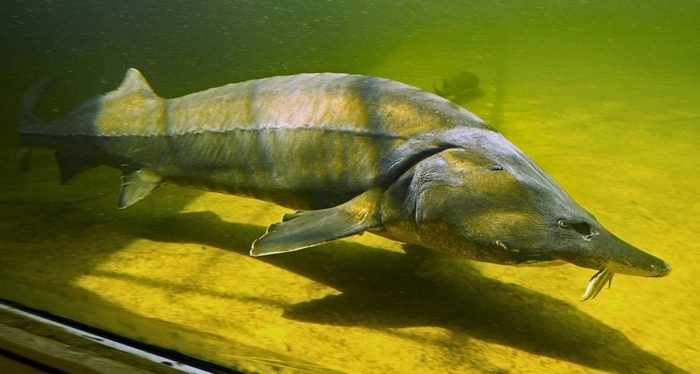Sturgeons are a group of fish belonging to the family Acipenseridae. Known for their large size, long lifespans, and ancient lineage, sturgeons have a history dating back over 200 million years, making them one of the oldest fish families.
Sturgeons are remarkable and ancient fish with significant ecological, economic, and cultural value. Ensuring their conservation and sustainable management is crucial for preserving these majestic creatures for future generations.

Species and their geographical distribution
Sturgeons are found primarily in the Northern Hemisphere, inhabiting both freshwater and marine environments.
Here are some notable species:
- Beluga (Huso huso): Found in the Caspian and Black Sea basins.
- White Sturgeon (Acipenser transmontanus): Native to the Pacific coast of North America.
- Atlantic Sturgeon (Acipenser oxyrinchus): Found along the Atlantic coast of North America.
- Russian Sturgeon (Acipenser gueldenstaedtii): Inhabits the Black Sea, Caspian Sea, and the Sea of Azov.
- Sterlet (Acipenser ruthenus): Found in the Danube and Volga rivers.
- Lake Sturgeon (Acipenser fulvescens): Native to the Great Lakes and Mississippi River basins.
- Green Sturgeon (Acipenser medirostris): Found along the Pacific coast of North America.
- Shortnose Sturgeon (Acipenser brevirostrum): Inhabits the rivers along the eastern coast of North America.
- Chinese Sturgeon (Acipenser sinensis): Found in the Yangtze River and coastal China.
Physical characteristics
Sturgeons have elongated bodies, bony scutes along their sides and back, and heterocercal tails. They can grow to impressive sizes, with the Beluga sturgeon being the largest, sometimes exceeding 5 meters (16 feet) in length and weighing over 1,000 kilograms (2,200 pounds).
Reproduction and lifespan
Sturgeons are slow-growing and late-maturing fish, with lifespans that can extend beyond a century. Sexually mature female sturgeons spawn every few years, producing thousands of eggs, which are harvested as caviar. This reproductive strategy makes them particularly vulnerable to overfishing, as it takes a long time for a young sturgeon to reach sexual maturity.
The average lifespan for a sturgeon is 50-60 years and it is uncommon for them to spawn until they are 15-20 years old. An individual female sturgeon will only spawn every few years and very specific conditions are required for spawning to take place, including a certain photoperiod in spring and access to clear, shallow water with rocks or gravel on the bottom.
Sturgeons are broadcast spawners and the eggs are sticky and adhere to rocks or gravel. During spawning, a female sturgeon can release anywher from 100,000 to 3 million eggs, but not all of them will be fertilized.
The fertilized eggs will only survive within a fairly limited temperature span, and vigorous oxygenation is also required. It takes 8-15 days for the embroys to develop into larval fish, and during this development they will get nutrients from the yolk sac.
After hatching, the larval fish is no longer attached to the subtrate, and it will be carried by the stream to backwaters (e.g. sloughs and oxbows) where it will live for several years. Free-swimming fry feed chiefly on crustacea and insect larvae, and can reach a lenght of up to 20 cm in their first year. Eventually, they become strong enough to seek out the swift-flowing parts of the river.
Behaviour
Adult sturgeons are chiefly benthic feeders and will extend their siphon-like mouths to suck food. They do not rely on their eyes to find prey, and are believed to utilize a combination of imput – including smell, tactile cues and chemosensory information. To this end, the sturgeon is equipped with four barbles and electroreception. The electroreceptors can detect the small electric fields generated by other animals. (It is possible that these electroreceptors are also useful for migration and mating.)
They eat a lot of crustaceans, shellfish and small fish. Some species, such as the White sturgeon and the Pallid sturgeon, are more piscivore than the others. Even though sturgeons have no teeth, some species are known to catch and devour large fish, even adult salmon.
Sturgeons can leap completely out of the water and the splash they make can be heard up to half a mile away on the surface. It is likely that this sound travels even further in the water, and it might be created deliberately as some type of group communication between sturgeons.
Sturgeons and humans
Sturgeons are economically significant, especially for their roe, which is processed into the luxury food product caviar. They also hold cultural importance in various regions.
As mentioned above, sturgeons can leap completely out of the water, and them landing on boats is not unheard of. In 2015, a 5-year-old girl died after being struck by a sturgeon that leaped out of the Suwannee River in the United States.
Conservation Status
Sturgeons play a vital role in maintaining healthy aquatic ecosystems, but are today threatened by overfishing, habitat destruction, and pollution. The high demand for caviar has led to drastic declines in wild populations. Conservation efforts include habitat restoration, captive breeding programs, and strict fishing regulations.
Ethymology
The English word sturgeon comes from the Old English word styrġa. It is ultimately derived from the Proto-Indo-European word *str̥(Hx)yón.
